Effect of Modulation Period on the Microstructure and Tribological Properties of AlCrTiVNbN/TiSiN Nano Multilayer Films
Abstract
1. Introduction
2. Experimental Details
2.1. Film Deposition
2.2. Characterization of Film Properties
3. Results and Discussion
3.1. Microstructure
3.2. Mechanical Properties
3.3. Tribological Characteristics
4. Conclusions
- (1)
- All prepared films displayed an FCC structure with a preferred planar direction of (200). As λ increased, the interplanar distance decreased and the surface roughness increased.
- (2)
- The nano multilayer film with λ = 4 nm (M4) showed a smooth surface with small particles. It also demonstrated the highest hardness of 15.51 ± 0.16 GPa and elastic modulus of 182.89 ± 2.38 GPa, along with the peak H/E (0.084) and H3/E2 (0.111) ratios. As λ increased, the hardness and elastic modulus of the films declined. This was ascribed to the solution strengthening and the formation of a compression and tensile alternating stress field between the TiSiN and AlCrTiVNbN layers.
- (3)
- As λ increased, the COF of the films and the wear rate of the films increased. The film with λ = 4 nm (M4) showed the lowest COF of 0.73 and the wear rate equal to (8.29 ± 0.18) × 10−8 mm3∙N−1∙m−1. The oxidation products decreased surface abrasion and displayed self-lubrication during the tribological process. The wear mechanism included abrasive wear, adhesive wear, and oxidation wear.
Author Contributions
Funding
Institutional Review Board Statement
Informed Consent Statement
Data Availability Statement
Acknowledgments
Conflicts of Interest
References
- Luo, D.; Zhou, Q.; Huang, Z.; Li, Y.; Liu, Y.; Li, Q.; He, Y.; Wang, H. Tribological Behavior of High Entropy Alloy Coatings: A Review. Coatings 2022, 12, 1428. [Google Scholar] [CrossRef]
- Xu, Y.; Li, G.; Xia, Y. Synthesis and characterization of super-hard AlCrTiVZr high-entropy alloy nitride films deposited by HiPIMS. Appl. Surf. Sci. 2020, 523, 146529. [Google Scholar] [CrossRef]
- Zhang, X.; Pelenovich, V.; Liu, Y.; Ke, X.; Zhang, J.; Yang, B.; Ma, G.; Li, M.; Wang, X. Effect of bias voltages on microstructure and properties of (TiVCrNbSiTaBY)N high entropy alloy nitride coatings deposited by RF magnetron sputtering. Vacuum 2022, 195, 110710. [Google Scholar] [CrossRef]
- Zhao, Y.Q.; Mu, Y.T.; Liu, M. Mechanical properties and friction-wear characteristics of VN/Ag multilayer coatings with heterogeneous and transition interfaces. Trans. Nonferrous Met. Soc. China 2020, 30, 472–483. [Google Scholar] [CrossRef]
- Ren, B.; Zhao, R.F.; Zhang, G.P.; Liu, Z.X.; Cai, B.; Jiang, A.Y. Microstructure and properties of the AlCrMoZrTi/(AlCrMoZrTi)N multilayer high-entropy nitride ceramics films deposited by reactive RF sputtering. Ceram. Int. 2022, 48, 16901–16911. [Google Scholar] [CrossRef]
- Wang, L.P.; Qi, J.L.; Cao, Y.Q.; Zhang, K.; Wen, M. N-rich Zr3N4 nanolayers-dependent superhard effect and fracture behavior in TiAlN/Zr3N4 nanomultilayer films. Ceram. Int. 2020, 46, 19111–19120. [Google Scholar] [CrossRef]
- Zhang, Y.T.; He, X.; Wang, N.; Wang, L.P.; Pang, H.P.; Hao, J.; Wen, M.; Qi, J. Insight into deformation modes of bcc-Nb/fcc-Cantor nanomultilayer film. Surf. Coat. Technol. 2025, 497, 131751. [Google Scholar] [CrossRef]
- Yang, M.; Fan, X.; Ren, S.; Wang, L. Enhanced environmental adaptability of sandwich-like MoS2/Ag/WC nanomultilayer films via Ag nanoparticle diffusion-dominated defect repair. Mater. Horiz. 2024, 11, 5230–5243. [Google Scholar] [CrossRef]
- Zhang, Z.; Jin, P.; Chen, Y.H.; Zhang, T.F.; Gyawali, G.; Zhu, X.Z.; Li, G.F.; Zhang, S.H. Enhanced corrosion and tribo-corrosion resistance of self-organized nano-multilayer oxynitride coatings on tungsten copper alloy. Corros. Sci. 2025, 246, 112740. [Google Scholar] [CrossRef]
- Lu, X.; Zeng, L.F.; Zhang, J.H.; Li, S.Y.; Jiang, P.G. Significant enhancement in the strength and thermal stability of Cu/Nb nano-multilayer via a minor Ag doping. J. Alloys Compd. 2025, 1022, 180035. [Google Scholar] [CrossRef]
- Yeom, J.; Lorenzin, G.; Claudia, C.; Jolanta, J.-R. The thermal stability and degradation mechanism of Cu/Mo nanomultilayers. Sci. Technol. Adv. Mater. 2024, 25, 2357536. [Google Scholar] [CrossRef]
- Kim, T.; Han, S.; Lee, J.; Na, Y.; Jung, J.; Park, Y.C.; Oh, J.; Yang, C.; Kim, H.Y. Development and Characterization of Low Temperature Wafer-Level Vacuum Packaging Using Cu-Sn Bonding and Nanomultilayer Getter. Micromachines 2023, 14, 448. [Google Scholar] [CrossRef]
- Wang, Y.X.; Wang, D. Effects of yttrium doping on high-temperature oxidation, friction, and wear properties of CrAlN films. Mater. Res. Express 2024, 11, 016402. [Google Scholar] [CrossRef]
- Wang, Y.X.; Lou, B.Y. Microstructure and High-Temperature Friction and Wear Properties of CrAlMoN Film. Oxid. Met. 2021, 95, 239–250. [Google Scholar] [CrossRef]
- Wang, Y.X.; Ji, Y. Influence of Mo Doping on the Microstructure, Friction, and Wear Properties of CrAlN Films. J. Mater. Eng. Perform. 2021, 30, 1938–1944. [Google Scholar] [CrossRef]
- Petkov, N.; Bakalova, T.; Bahchedzhiev, H.; Krafka, M.; Lemberk, L. Modulation period effect on the CrN/TiN coating properties. J. Nano Res. 2023, 79, 37–48. [Google Scholar] [CrossRef]
- Luo, Y.; Dong, Y.; Xiao, C.; Wang, X.; Peng, H. Impact Abrasive Wear Property of CrAlN/TiSiN Multilayer Coating at Elevated Temperatures. Materials 2022, 15, 2214. [Google Scholar] [CrossRef]
- Qi, J.L.; Wang, L.P.; Zhang, Y.; Guo, X.; Yu, W.Q.; Wang, Q.H.; Zhang, K.; Ren, P.; Wen, M. Amorphous AlN nanolayer thickness dependent toughness, thermal stability and oxidation resistance in TaN/AlN nanomultilayer films. Surf. Coat. Technol. 2021, 405, 126724. [Google Scholar] [CrossRef]
- Hao, J.; Wang, L.P.; Zhao, C.; Zhang, K.; Qi, J.L.; Pang, H.P.; Ren, P.; Wen, M. Effects of interface configurations on strengthening-toughening and tribological behaviors of TiC/Ti nano-multilayers. Surf. Coat. Technol. 2025, 497, 131726. [Google Scholar] [CrossRef]
- Zaid, H.; Tanaka, K.; Ciobanu, C.V.; Yang, J.M.; Kodambaka, S.; Kindlund, H. Growth of elastically-stiff, nanostructured, high-entropy alloy nitride, (VNbTaMoW)N/Al2O3(0001) thin film. Scr. Mater. 2021, 197, 113813. [Google Scholar] [CrossRef]
- Yuan, Y.; Xiao, Y.L.; Yu, C.T.; Xuan, L.; Azfar, H.; Jiao, L.Z.; Jun, J.L.; Chao, Y.; Hui, C.; Rui, L. Characterization of interface properties and enhancement of thermal hardness in TiN/(CrVTaTiW)Nx multilayered structures: Investigating diverse crystallization templates. J. Alloys Compd. 2025, 1020, 179440. [Google Scholar] [CrossRef]
- Tu, Y.; Li, J.; Yuan, Y.; Zhao, J.; Hameed, A.; Yan, C.; Chen, H.; Lan, R.; Cheng, B.; Wang, P.; et al. Thickness modulation influenced mechanical properties of TiN/(CrVTaTiW)Nx multilayer coatings. Ceram. Int. 2024, 50, 53007–53014. [Google Scholar] [CrossRef]
- Zhai, Q.; Li, W.; Liu, P.; Cheng, W.; Zhang, K.; Ma, F.; Chen, X.; Feng, R.; Liaw, P.K. Mechanical Behavior and Thermal Stability of (AlCrTiZrMo)N/ZrO2 Nano-Multilayered High-Entropy Alloy Film Prepared by Magnetron Sputtering. Crystals 2022, 12, 232. [Google Scholar] [CrossRef]
- Wang, Y.; Hao, E.; An, Y.; Chen, J.; Zhou, H. Effects of microstructure and mechanical properties on cavitation erosion resistance of NiCrWMoCuCBFe coatings. Appl. Surf. Sci. 2021, 547, 149125. [Google Scholar] [CrossRef]
- Li, B.H.; Ma, X.; Li, W.; Zhai, Q.Q.; Liu, P.; Zhang, K.; Ma, F.C.; Wang, J.J. Effect of SiC thickness on microstructure and mechanical properties of (AlCrTiZrV)N/SiC nano-multilayers film synthesized by reactive magnetron sputtering. Thin Solid Film. 2021, 730, 138724. [Google Scholar] [CrossRef]
- Yan, H.; Si, L.; Dou, Z.; Yang, Y.; Li, H.; Liu, F. Cavitation Erosion Resistance of TiSiN/NiTiAlCoCrN Nanomultilayer Films with Different Modulation Periods. Coatings 2023, 13, 1431. [Google Scholar] [CrossRef]
- Cheng, W.J.; Liu, P.; Zhu, X.F.; Meng, Y.; Lu, H.M.; Li, W. Effects of modulation layer thickness on microstructures and mechanical behavior of VN/TiN-Ni nano-multilayered films. Trans. Nonferrous Met. Soc. China 2025, 24. Available online: https://link.cnki.net/urlid/43.1239.tg.20250318.1056.011 (accessed on 1 March 2025).
- Yong, Q.F.; Fei, Z.; Qian, Z.W.; Mao, D.Z.; Zhi, F.Z.; Li, L.K.Y. The influence of Mo target current on the microstructure, mechanical and tribological properties of CrMoSiCN coatings in artificial seawater. J. Alloys Compd. 2019, 791, 800–813. [Google Scholar]
- Li, C.; Wang, L.; Shang, L.; Cao, X.Q.; Zhang, G.; Yu, Y.; Li, W.S.; Zhang, S.Z.; Hu, H.T. Mechanical and high-temperature tribological properties of CrAlN/TiSiN multilayer coating deposited by PVD. Ceram. Int. 2021, 47, 29285–29294. [Google Scholar] [CrossRef]
- Chen, Z.L.; Lou, M.; Geng, D.S.; Xu, Y.X.; Wang, Q.M.; Zheng, J.; Zhu, R.Y.; Chen, Y.B.; Kim, K.H. Effect of the modulation geometry on mechanical and tribological properties of TiSiN/TiAlN nano-multilayer coatings. Surf. Coat. Technol. 2021, 423, 127586. [Google Scholar] [CrossRef]
- Zhu, S.; Zhang, B.S.; Tao, X.W.; Yu, Y.Q.; Zhang, Z.J.; Wang, Z.; Lu, B. Microstructure and Tribology Performance of Plasma-Clad Intermetallic-Reinforced CoCrFeMnNi-Based High-Entropy Alloy Composite Coatings. Tribol. Trans. 2020, 64, 264–274. [Google Scholar] [CrossRef]
- Chen, X.; Ma, Y.; Yang, Y.; Meng, A.; Han, Z.X.; Han, Z.; Zhao, Y.H. Revealing tribo–oxidation mechanisms of the copper–WC system under high tribological loading. Scr. Mater. 2021, 204, 114142. [Google Scholar] [CrossRef]
- Bolelli, G.; Steduto, D.; Kiilakoski, J.; Varis, T.; Lusvarghi, L.; Vuoristo, P. Tribological properties of plasma sprayed Cr2O3, Cr2O3–TiO2, Cr2O3–Al2O3 and Cr2O3–ZrO2 coatings. Wear 2021, 480–481, 203931. [Google Scholar] [CrossRef]

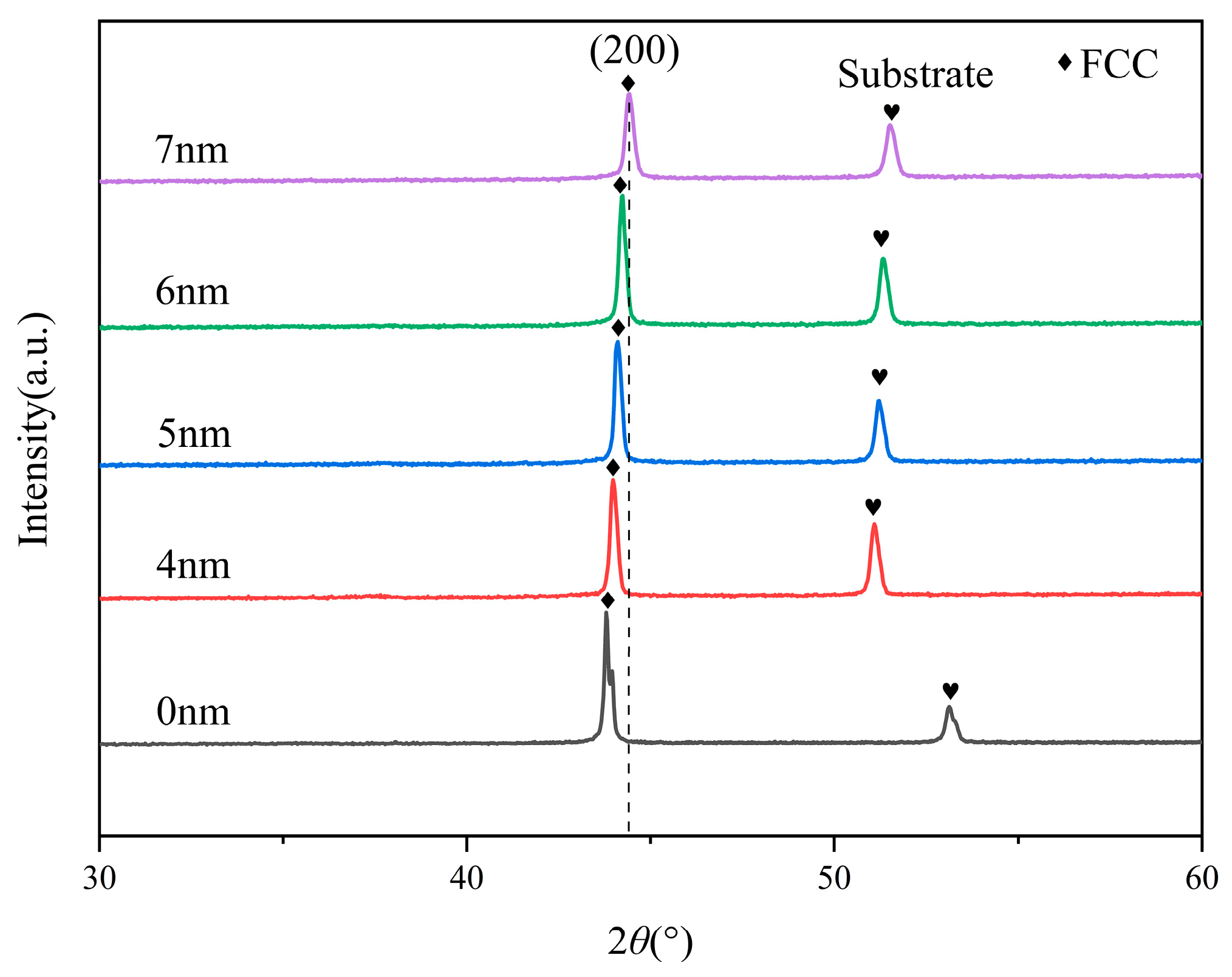


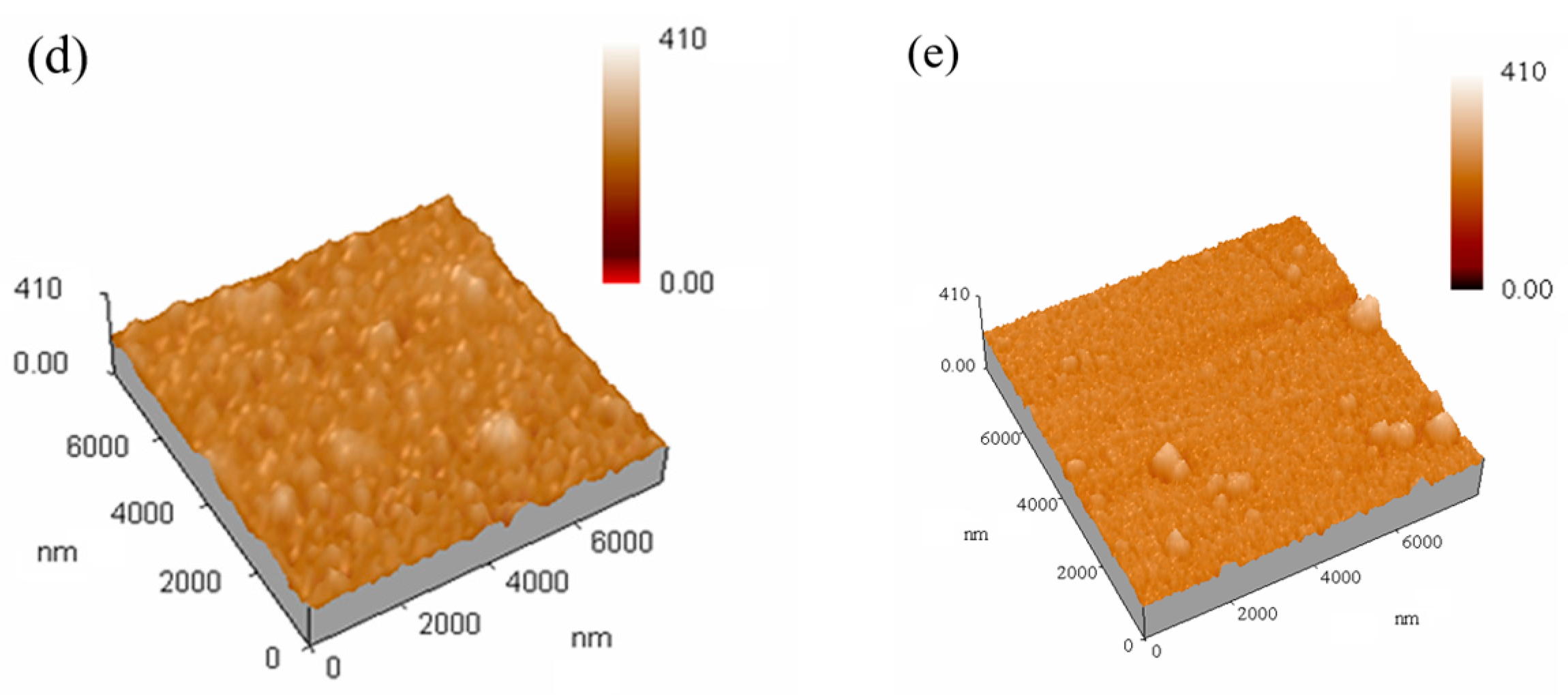
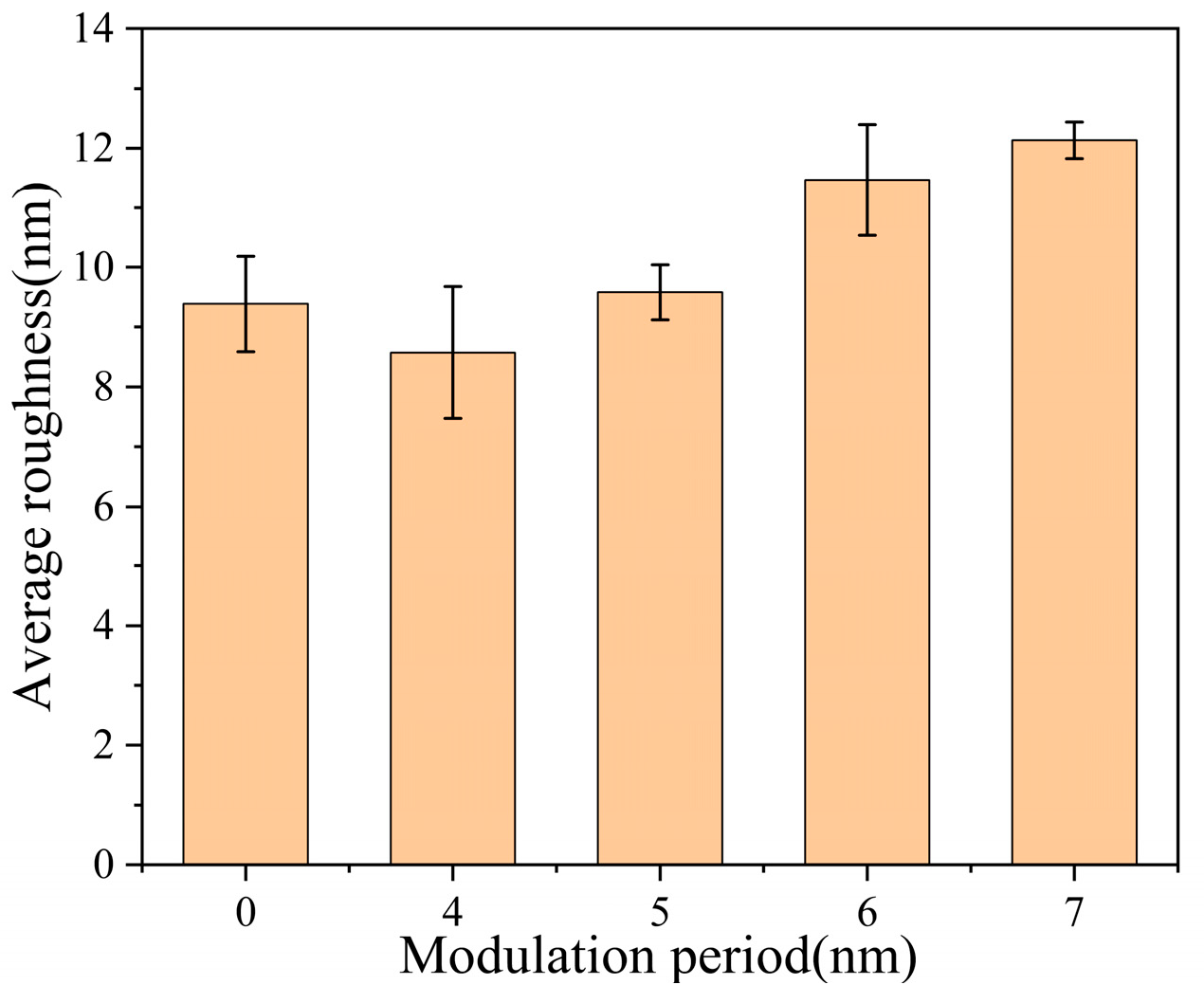
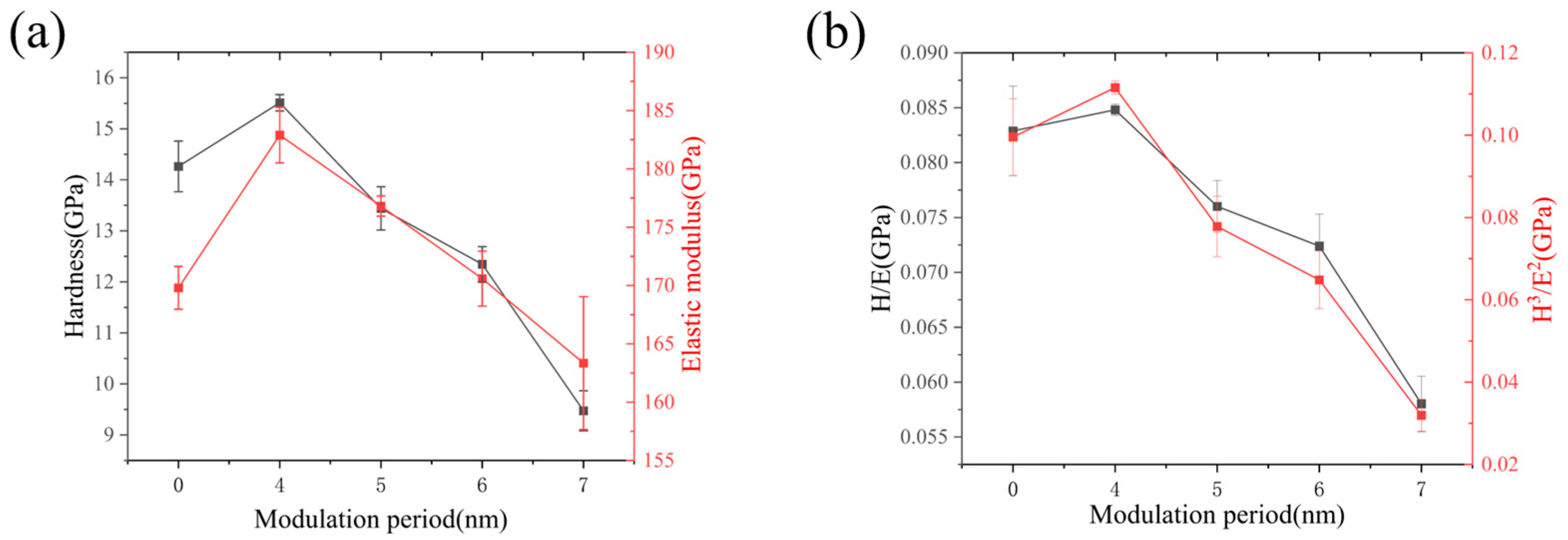



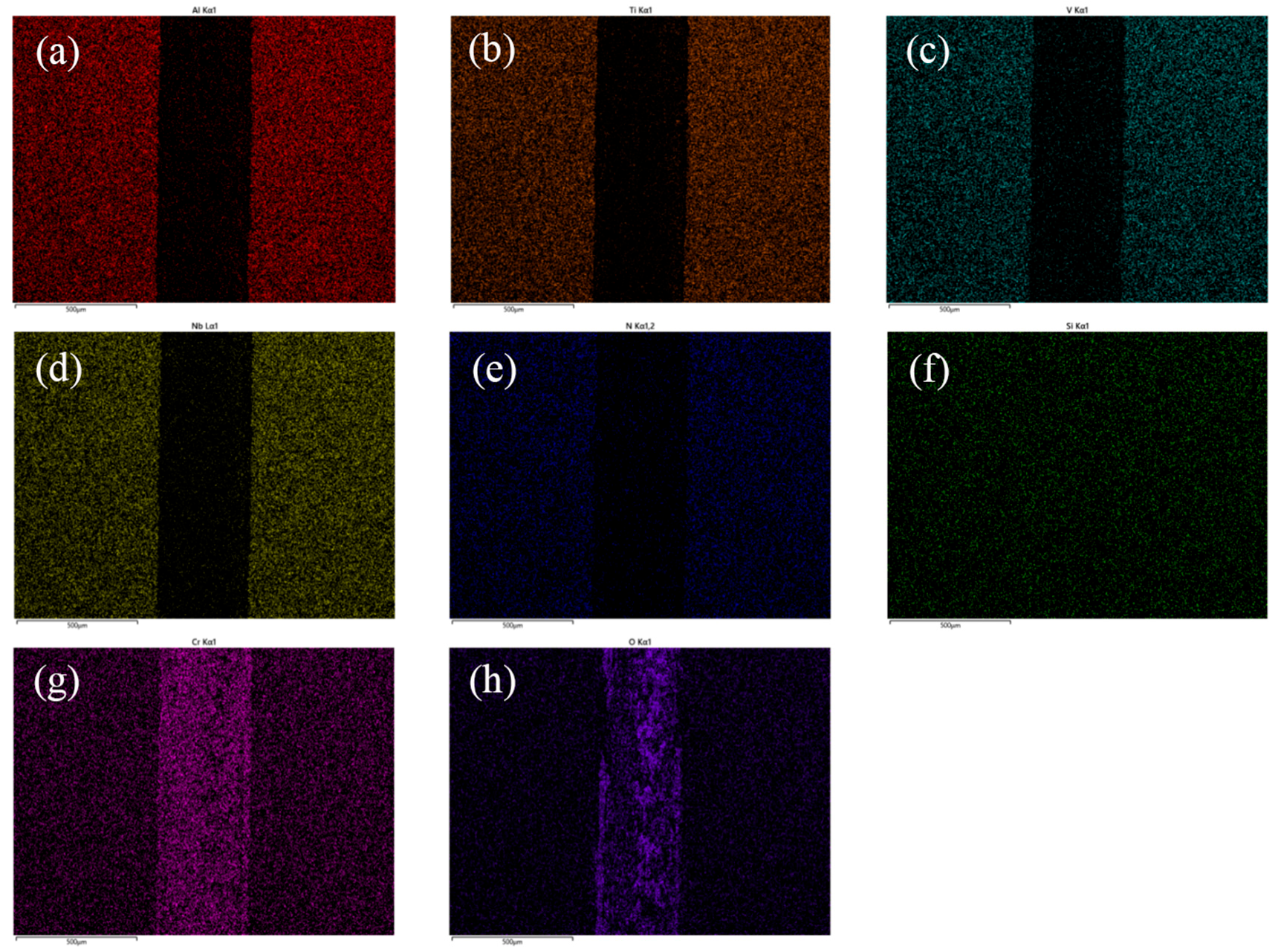
| Abbr. | Thickness of TiSiN Layer/nm | Deposition Time/s | λ/nm | Cycles/N |
|---|---|---|---|---|
| M4 | 1 | 23 | 4 | 250 |
| M5 | 2 | 46 | 5 | 200 |
| M6 | 3 | 69 | 6 | 146 |
| M7 | 4 | 92 | 7 | 123 |
| Abbr. | λ/nm | 2θ/(°) | Interplanar Distance/nm | FWHM/rad |
|---|---|---|---|---|
| 0 | 43.795 | 0.2066 | 0.1875 | |
| M4 | 4 | 43.978 | 0.2057 | 0.1902 |
| M5 | 5 | 44.110 | 0.2051 | 0.1913 |
| M6 | 6 | 44.241 | 0.2045 | 0.1920 |
| M7 | 7 | 44.425 | 0.2038 | 0.2292 |
| Abbr. | λ/nm | Average Hardness/GPa | Elastic Modulus/GPa |
|---|---|---|---|
| 0 | 14.264 | 169.796 | |
| M4 | 4 | 15.510 | 182.895 |
| M5 | 5 | 13.440 | 176.811 |
| M6 | 6 | 12.345 | 170.586 |
| M7 | 7 | 9.4723 | 163.350 |
Disclaimer/Publisher’s Note: The statements, opinions and data contained in all publications are solely those of the individual author(s) and contributor(s) and not of MDPI and/or the editor(s). MDPI and/or the editor(s) disclaim responsibility for any injury to people or property resulting from any ideas, methods, instructions or products referred to in the content. |
© 2025 by the authors. Licensee MDPI, Basel, Switzerland. This article is an open access article distributed under the terms and conditions of the Creative Commons Attribution (CC BY) license (https://creativecommons.org/licenses/by/4.0/).
Share and Cite
Yan, H.; Wang, H.; Li, X.; Dou, Z.; Liu, F. Effect of Modulation Period on the Microstructure and Tribological Properties of AlCrTiVNbN/TiSiN Nano Multilayer Films. Coatings 2025, 15, 839. https://doi.org/10.3390/coatings15070839
Yan H, Wang H, Li X, Dou Z, Liu F. Effect of Modulation Period on the Microstructure and Tribological Properties of AlCrTiVNbN/TiSiN Nano Multilayer Films. Coatings. 2025; 15(7):839. https://doi.org/10.3390/coatings15070839
Chicago/Turabian StyleYan, Hongjuan, Haoran Wang, Xiaona Li, Zhaoliang Dou, and Fengbin Liu. 2025. "Effect of Modulation Period on the Microstructure and Tribological Properties of AlCrTiVNbN/TiSiN Nano Multilayer Films" Coatings 15, no. 7: 839. https://doi.org/10.3390/coatings15070839
APA StyleYan, H., Wang, H., Li, X., Dou, Z., & Liu, F. (2025). Effect of Modulation Period on the Microstructure and Tribological Properties of AlCrTiVNbN/TiSiN Nano Multilayer Films. Coatings, 15(7), 839. https://doi.org/10.3390/coatings15070839





